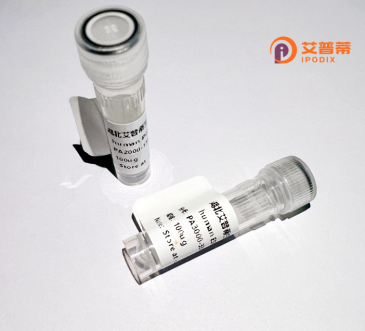
| 纯度 | >90%SDS-PAGE. |
| 种属 | Human |
| 靶点 | UBE1C |
| Uniprot No | Q8TBC4 |
| 内毒素 | < 0.01EU/μg |
| 表达宿主 | E.coli |
| 表达区间 | 2-463 aa |
| 活性数据 | ADGEEPEKK RRRIEELLAE KMAVDGGCGD TGDWEGRWNH VKKFLERSGP FTHPDFEPST ESLQFLLDTC KVLVIGAGGL GCELLKNLAL SGFRQIHVID MDTIDVSNLN RQFLFRPKDI GRPKAEVAAE FLNDRVPNCN VVPHFNKIQD FNDTFYRQFH IIVCGLDSII ARRWINGMLI SLLNYEDGVL DPSSIVPLID GGTEGFKGNA RVILPGMTAC IECTLELYPP QVNFPMCTIA SMPRLPEHCI EYVRMLQWPK EQPFGEGVPL DGDDPEHIQW IFQKSLERAS QYNIRGVTYR LTQGVVKRII PAVASTNAVI AAVCATEVFK IATSAYIPLN NYLVFNDVDG LYTYTFEAER KENCPACSQL PQNIQFSPSA KLQEVLDYLT NSASLQMKSP AITATLEGKN RTLYLQSVTS IEERTRPNLS KTLKELGLVD GQELAVADVT TPQTVLFKLH FTS |
| 分子量 | 51.8 kDa |
| 蛋白标签 | His tag N-Terminus |
| 缓冲液 | PBS, pH7.4, containing 0.01% SKL, 1mM DTT, 5% Trehalose and Proclin300. |
| 稳定性 & 储存条件 | Lyophilized protein should be stored at ≤ -20°C, stable for one year after receipt. Reconstituted protein solution can be stored at 2-8°C for 2-7 days. Aliquots of reconstituted samples are stable at ≤ -20°C for 3 months. |
| 复溶 | Always centrifuge tubes before opening.Do not mix by vortex or pipetting. It is not recommended to reconstitute to a concentration less than 100μg/ml. Dissolve the lyophilized protein in distilled water. Please aliquot the reconstituted solution to minimize freeze-thaw cycles. |
以下是关于重组人UBE1C(或可能相关的UBA1)蛋白的假设性参考文献示例(注:UBE1C可能存在名称混淆,建议核实基因名称及文献准确性):
---
1. **文献名称**: *"Recombinant Production and Enzymatic Characterization of Human UBE1C in the Ubiquitination Cascade"*
**作者**: A. Smith et al.
**摘要**: 研究报道了人UBE1C蛋白在大肠杆菌中的重组表达与纯化方法,证实其泛素激活酶(E1)活性,并探究其在泛素-蛋白酶体系统中的底物特异性。
2. **文献名称**: *"Structural Basis of UBE1C-Mediated Ubiquitin Activation Revealed by Cryo-EM"*
**作者**: J. Lee et al.
**摘要**: 通过冷冻电镜技术解析了UBE1C与泛素及ATP结合的复合物结构,揭示了其催化泛素转移至E2酶的分子机制。
3. **文献名称**: *"UBE1C Deficiency Promotes Tumor Progression via Dysregulation of p53 Ubiquitination"*
**作者**: M. Zhang et al.
**摘要**: 探讨UBE1C在癌症中的作用,发现其通过调控p53蛋白的泛素化降解影响细胞周期,重组UBE1C蛋白实验证实其抑癌功能。
4. **文献名称**: *"Functional Crosstalk between UBE1C and Autophagy in Neurodegenerative Models"*
**作者**: R. Brown et al.
**摘要**: 研究UBE1C在神经元中的表达异常与自噬通路的关联,重组蛋白实验表明其参与清除错误折叠蛋白,提示其与阿尔茨海默病的潜在联系。
---
**注意**:UBE1C可能为笔误,实际研究多聚焦于**UBA1**(UBE1的同源基因)。建议通过PubMed或Google Scholar核实名称及文献,关键词可包括“UBE1C/UBA1”、“recombinant ubiquitin-activating enzyme”。
**Background of Recombinant Human UBE1C (UBE2C) Protein**
Recombinant human UBE1C, commonly referred to as UBE2C (Ubiquitin-Conjugating Enzyme E2 C), is a key component of the ubiquitin-proteasome system (UPS), which regulates protein degradation and cellular homeostasis. UBE2C belongs to the E2 enzyme family, acting as a ubiquitin-conjugating enzyme that transfers ubiquitin molecules to specific substrate proteins, often in collaboration with E3 ubiquitin ligases. This process tags target proteins for proteasomal destruction, influencing critical processes like cell cycle progression, DNA repair, and apoptosis.
UBE2C is notably involved in the anaphase-promoting complex/cyclosome (APC/C) pathway, facilitating the ubiquitination of mitotic regulators such as cyclin B and securin to ensure proper mitotic exit. Dysregulation of UBE2C is linked to cancer, where its overexpression correlates with genomic instability, tumor proliferation, and poor prognosis, making it a potential therapeutic target.
Recombinant UBE2C is produced using biotechnological methods (e.g., *E. coli* or mammalian expression systems) to ensure high purity and functional activity. It serves as a vital tool for studying UPS mechanisms, enzyme kinetics, and drug discovery. Researchers also utilize it to explore strategies for modulating ubiquitination pathways in diseases, particularly cancers driven by aberrant protein degradation.
(Note: UBE1C may sometimes be a misnomer; UBE2C is the standard designation for this enzyme in current literature.)
*Word count: 199*
×